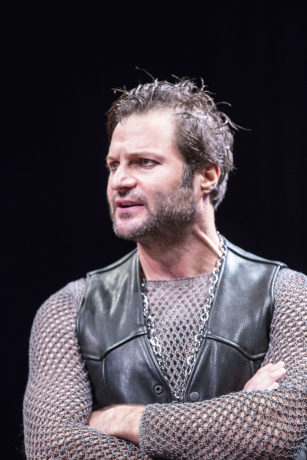Since 2011, the Pennsylvania Shakespeare Festival has presented one play a year in its “Extreme Shakespeare” series. The concept is to try to recreate in part the process believed to have been used in Shakespeare’s era, in which the actors come together at the theater, with their lines already learned, wearing whatever they choose, for just a few days of rehearsal before their opening public performance – all without the benefit of a director or designers. It’s an interesting experiment, but does it work for an audience accustomed to their contributions?
This year’s offering and the sixth in the series is Troilus and Cressida, the rarely-produced ‘problem play’ of circa 1602, which defies easy categorization. Combining elements of comedy, tragedy, history, and romance, the Bard’s story takes its inspiration from the pseudo-Homeric medieval tale of the titular lovers, popularized in Chaucer’s epic poem “Troilus and Criseyde” of the 1380s, set within the ancient narrative of the late years of the long Trojan War and containing the legendary cast of characters from Greek mythology, as recounted in Homer’s Iliad (ca. 750 BC).

Cut with clarity and focus by actor Greg Wood, the complex multi-figured script retains the diversity of elements that Shakespeare incorporated (and which we all experience in life), with its momentous events and relationships, its sardonic wit and devastating sadness, and its still-unheeded moral about the ravages of war, the dangers of pride, and the betrayal of honor (in which can be seen parallels with Shakespeare’s own time, and with ours). Even without the guidance of a director, the cast is equally clear and appropriate in its blocking of the action, moving easily and purposefully, while making use of the surrounding space, aisles, and the mostly bare stage – furnished with two benches and a classicizing post-and-lintel curtained backdrop (appropriated from another show). The fight choreography, too, employing wrestling, swordfights, knives, and a group assault of non-consensual kissing and touching, is impressively invented and executed by the actors themselves.
According to the PSF’s Producing Artistic Director Patrick Mulcahy, members of the cast were given two hours upon arrival to scavenge through the company’s cache of costumes and props, to select what they’d like for their roles and scenes. Here the result is a discordant mash-up of anachronisms that breaks the overall consistency of the production and visually distracts from the historical narrative. Wearing everything from current jeans and tee-shirts, to 20th-century European military uniforms, old Hollywood glam, and robes that evoke the Middle Ages, and carrying a pan-temporal array of weapons and accoutrements, the absence of a designer’s homogeneous vision is obvious. Especially jarring is the characterization of Carl Wallnau’s Pandarus, whose white suit and hat, flask of liquor, cigarette holder, and Southern accent come straight out of Tennessee Williams, not Shakespeare or antiquity, and take the farcical component of the play to a disruptive and disconcerting extreme. The cast does, however, harmonize in the predominant colors worn by the Greeks (black) and Trojans (red), which helps greatly to distinguish the sides in their final battles. The action is also supported by lighting cues borrowed from another show, which spotlight the actors and indicate daytime and night, and by brief segments of song (including The Penguins’1954 hit “Earth Angel”), signaling trumpets and drums, and the noise of the unseen crowds.
Younger members of the cast, including recent graduates of the theater program at DeSales University (where the PSF is located), have been given an invaluable opportunity to work with established actors and to learn the past methods of their craft. While all come fully prepared in terms of memorization, they are not yet as accomplished in their performance of Shakespeare and could have benefitted from some authoritative direction in the tempering of their histrionics, affectations of speech, and uneven recitations, which frequently lack in meter and in a believable connection to the emotions of the characters and the significance of their words.
With that said, nothing could detract from the brilliant performances of the seasoned Shakespearean masters, who bring to the stage profound feeling, insightful wit, and a thorough facility with the Elizabethan language and rhythm, along with a mature apprehension of the personalities and a meaningful delivery of the tale’s inherent underlying message. Brandon J. Pierce and Mairin Lee beautifully capture the youthful passion, uncertainty, and pain of Troilus and Cressida. When he tells us “I’m giddy!” we feel the excitement of his love radiate throughout the theater; when she is used as chattel in the negotiations for peace, we have all we can do to keep from jumping up and intervening on her behalf.

Anthony Lawton, who delivers crucial messages as Aeneas, and Luigi Sottile as the respected warrior Hector (the Trojans) are well-matched with Lindsay Smiling, Justin Adams, Greg Wood, and Eric Hissom, as the high-ranking Agamemnon, the vicious Achilles, the wise and crafty Ulysses, and the elderly Nestor (the Greeks). All define their characters with distinction and credibility, capturing Shakespeare’s cynical humor with subtlety, and commanding the stage every moment they’re on it. And Susan Riley Stevens – playing traditionally male roles, in a reversal of the all-male casts in Elizabethan theater – provides both the physical comedy and the hilariously brutal socio-political commentary on the war, its heroes, and pawns, as the vile and insulting, but incisively observant slave Thersites, who acts the fool but speaks the truth.
The “extreme” presentation of Troilus and Cressida is a mixed bag. Some might find the unexpected juxtapositions and anachronisms amusing, in keeping with the nature of the play’s satirical content, while others will find them intrusive and indicative of the value of unified direction and design. But everyone should see in it Shakespeare’s universal themes and unparalleled writing, and the very human portrayals by the outstanding experts in the cast.
Running Time: Approximately two hours and 30 minutes, including an intermission.
Troilus and Cressida plays through Sunday, August 6, 2017 at the Pennsylvania Shakespeare Festival, Schubert Theatre – 2755 Station Avenue, in Center Valley, PA, on the Campus of DeSales University. For tickets, call (610) 282-WILL, or purchase them online.





